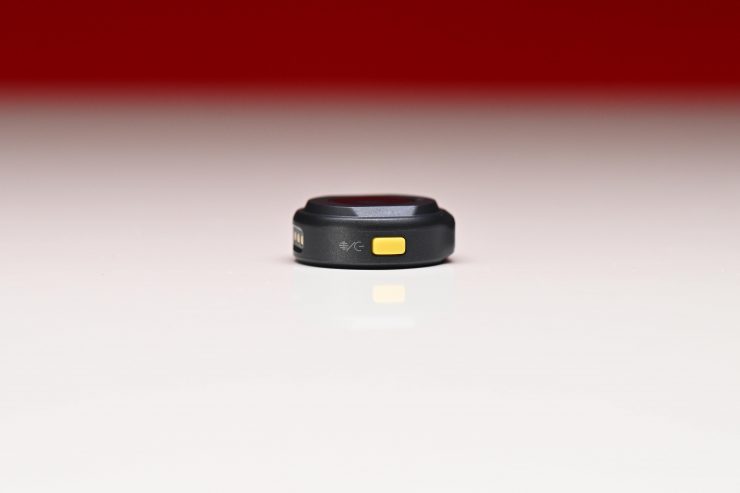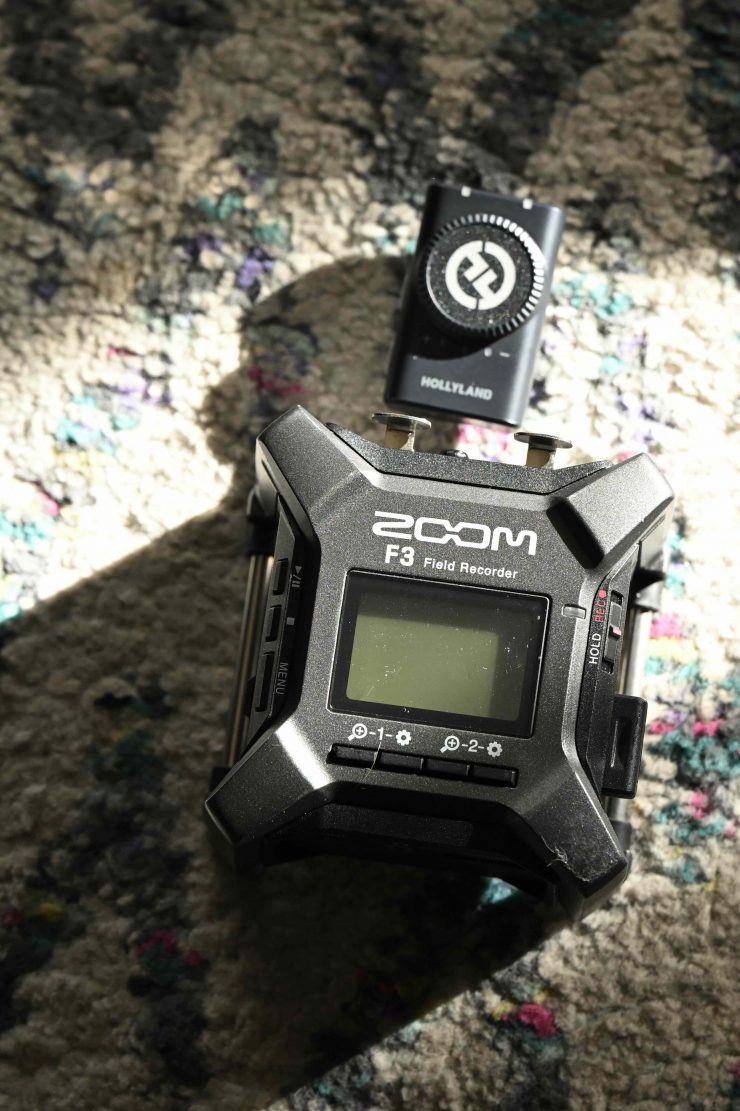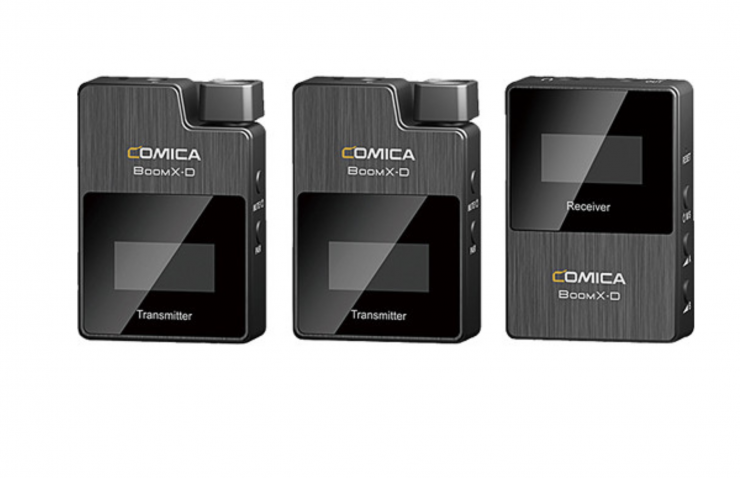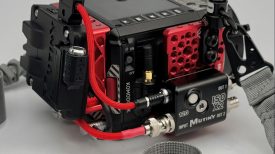
Hollyland recently announced its new LARK M2 wireless microphone system. It is being touted as a lightweight wireless microphone solution for filmmakers, vloggers, and podcasters.

Like most budget wireless audio systems the LARK M2 utilizes 2.4G wireless Adaptive Frequency Hopping (AFH) technology.
Since the launch of the original RØDE Wireless Go, which at the time was the world’s smallest wireless microphone system, we have seen a plethora of options come to market with fairly similar features. The RØDE Wireless Go immediately struck a chord with budget filmmakers, YouTubers, and Vloggers and that is undoubtedly why we have seen so many other companies releasing similar systems over the years.
Most of the small-sized budget wearable wireless audio systems have all had a small square or rectangular-style design. The LARK M2 bucks that trend and Hollyland has managed to make a very small and round wireless audio TX with a built-in microphone.
While it certainly isn’t the first wireless microphone system to feature round, circular TX units, it is, at least to my knowledge, the first one to be this small.
Concept
The concept behind the LARK M2 was simple, make an extremely cost-effective, compact, and more discreet wearable microphone, that was easy to use and that could work with a wide array of devices.
As I mentioned earlier, the target audience for this product is undoubtedly vloggers, filmmakers on a budget, anyone live streaming, and social media content creators.
Key features
- TX version weighs 9g, mobile version RX 6g, and camera version RX 14.8g
- Perfect for filmmakers, vloggers, podcasters and everyday use
- Adjustable environmental noise cancellation (ENC) for clear audio anywhere
- Outstanding audio performance
- Excellent 48kHz/24bit Hi-Fi sound
- Ergonomic and user-friendly
- Affordable and stylish – multiple package options
Build Quality

The build quality is what you would expect for a product at this price. The TX and RX units are very lightweight and they are made out of some sort of composite material.
For its intended audience and user base I wouldn’t expect it to have an all-metal construction like much more expensive wireless systems. I think the build quality will be perfectly sufficient for most users.
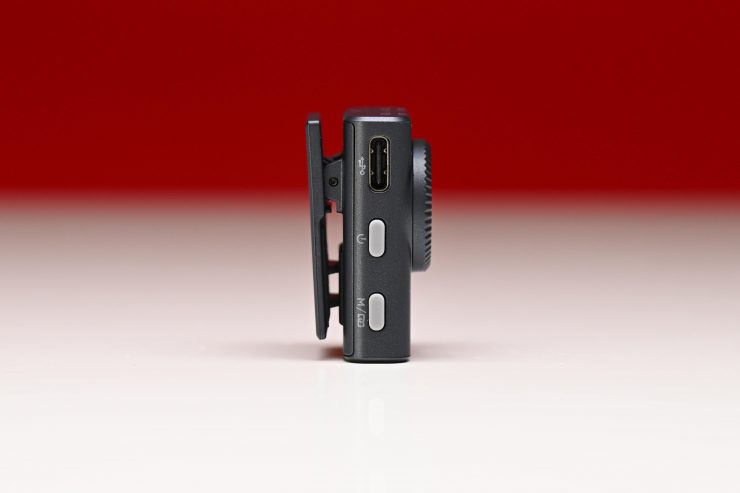
The plastic clip on the RX unit is similar to what you would find on a RØDE Wireless Go.
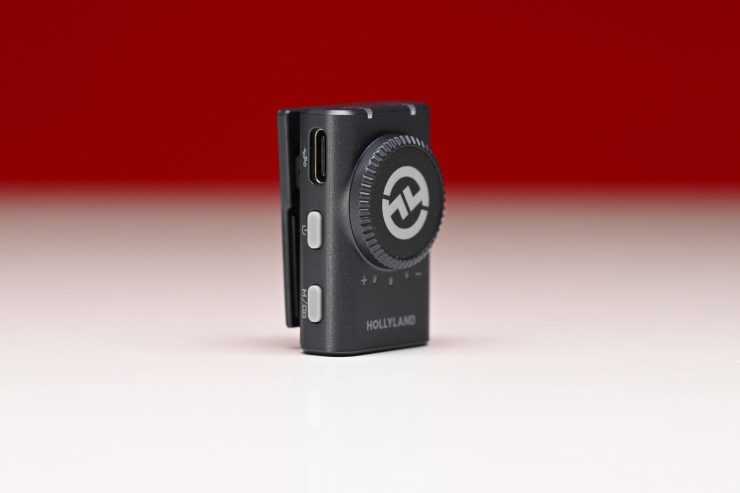
The buttons are reasonably tactile and easy to use.
Size & Weight
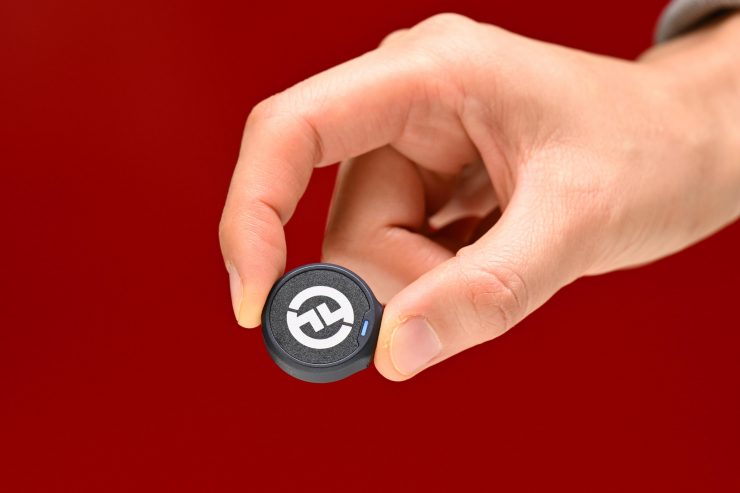

TX 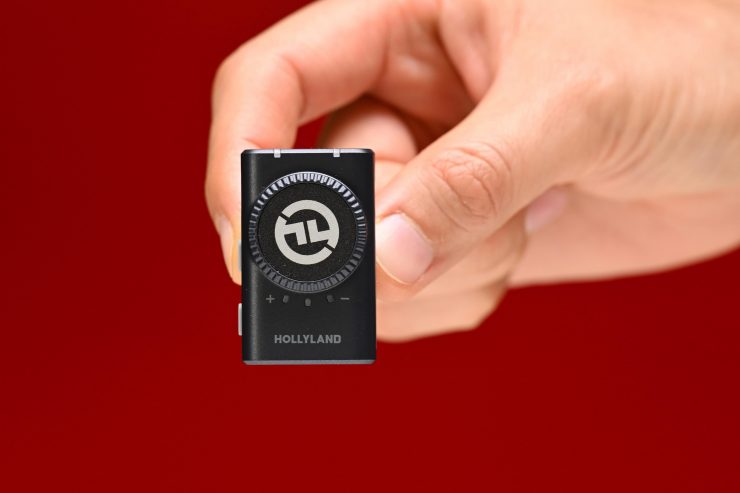
RX
This is where the LARK M2 has a big advantage over most other similar systems on the market. The TX unit is significantly smaller and lighter than almost all of the other competing products.

Above you can see how the Hollyland LARK M2 TX size compares to the Ulanzi U-Mic AM18 TX.

I think what is actually more impressive than the small weight and size is the decision to make the TX unit round instead of square or rectangular. This alone, at least in my opinion, makes it a more suitable option if you do need to clip it on a person where it will be in shot.

The TX units weighs just 9g / 0.32 oz and have physical dimensions of 1.0 x 0.4″ / 2.54 x 1 cm and the RX unit weighs 34.5g / 1.21 oz.

The Mobile Version RX units that come in Combo Version are also nice and small.

The LARK M2 TX weight of 9g doesn’t actually make it the lightest solution on the market. That title belongs to the PicoGear PicoMic 2 Pro whose TX actually weighs 1g less, but it has a rectangular form factor and not a round one. Its RX unit is also significantly larger and heavier than the LARK M2 RX.
For a product that is primarily going to be used as a stand-alone clip-on microphone, you certainly don’t want anything too heavy as it will put a strain on a shirt and look untidy.
How does the weight and size of TX unit compare to some other 2.4GHz systems on the market? Well, below you can see.
| WEIGHT | SIZE | |
| Hollyland LARK M2 | 9g / 0.32 oz | 1.0 x 0.4″ |
| PicoGear PicoMic 2 Pro | 8g / 0.28 oz | 1.7″ x 0.7″ x 0.28″ |
| RODE Wireless PRO | 35g / 1.2 oz | 1.8 x 1.7 x 0.8″ |
| RODE Wireless GO II | 30g / 1.1 oz | 1.7 x 1.8 x 0.7″ |
| DJI Mic 2 | 28g / 0.98 oz | 1.8 x 1.22 × 0.8″ |
| Synco WAir-G1-A2 | 35g / 1.2 oz | 2 x 1.7 x 0.6″ |
| Hollyland LARK 150 | 20.5g / 0.7 oz | 1.5 x 1.5 x 0.7″ |
| Ulanzi U-Mic AM18 | 23g / 0.8 oz | 1.4 x 1.8 x 0.6″ |
| Comica Audio BoomX-D D2 | 29g / 1 oz | 1.5 x 0.9 x 2.2″ |
| Godox MoveLink Mini UC | 12g / 0.4 oz | 2.1 x 0.8 x 0.7″ |
| Comica Audio Vimo C3 Mini | 13g / 0.5 oz | 0.6 x 0.8 x 2″ |
| Moza WE10 Pro | 34g / 1.2 oz | 1.7 x 2.4 x 0.8″ |
I am not going to feature every similar wireless microphone system in this comparison because there are so many on the market. I will stick to the ones that most people are familiar with.
Branding

The LARK M2 does have some small branding on it like just about every other similar system on the market. While it doesn’t have as much branding as something like a RØDE Wireless GO II/PRO (RØDE does have a tendency to overbrand its products), I would have preferred to have seen no logos at all.
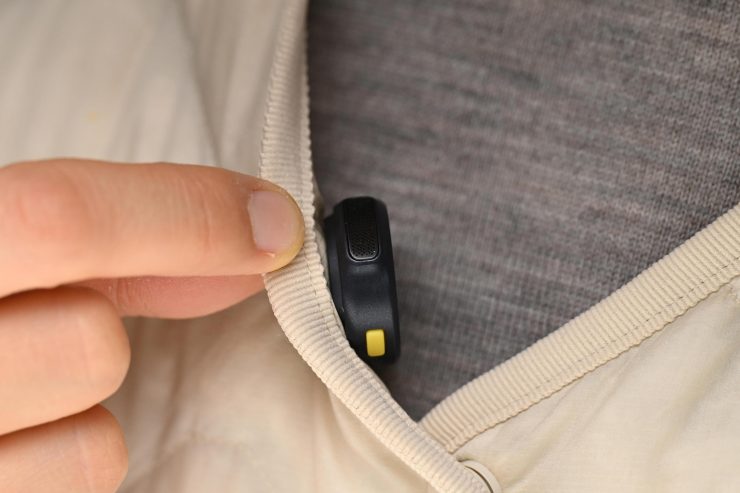
I almost always hide radio mic TX units so they are never seen, but the LARK M2 isn’t really a product that was designed for you to do that, however, because of its small size and footprint it is possible to conceal it to a certain extent.

I was shown a prototype of the LARK M2 last year and I suggested to the product manager that Hollyland should include some stickers because not everyone wants to see a logo in shot. I am sure I wasn’t the only one to mention this, and it was good to see that Hollyland was listening.

In the kit, Hollyland gives you a collection of stickers that you can use to cover the logo on the TX units. There are black-and-white options, as well as a bunch of emoji-style stickers that social media influencers may want to use.

The black sticker works reasonably well, although it is a little reflective when light hits it.

The only problem with keeping the TX units inconspicuous is that they have a blue LED light on them which the sticker doesn’t cover. I would have liked Hollyland to have made a feature in the app where you could turn this LED off. Although you could just use a bit of black tape to cover it over if you wanted to.
Numerous Mounting Options

Hollyland gives numerous ways to mount the TX units. The TX units feature a magnet on the back that you can use in conjunction with another small-sized round magnet to attach them to clothing, etc.
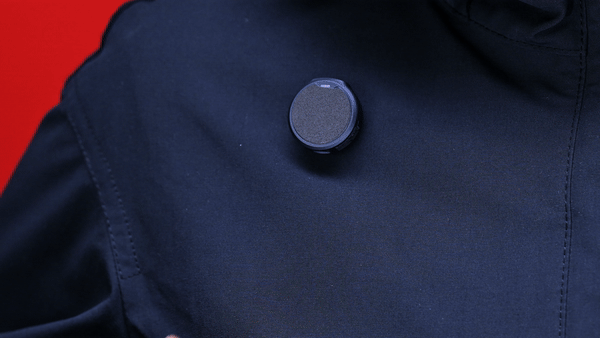
What is nice is that once it is attached using the magnets you can actually move the TX unit by simply holding it and moving it to a different position.
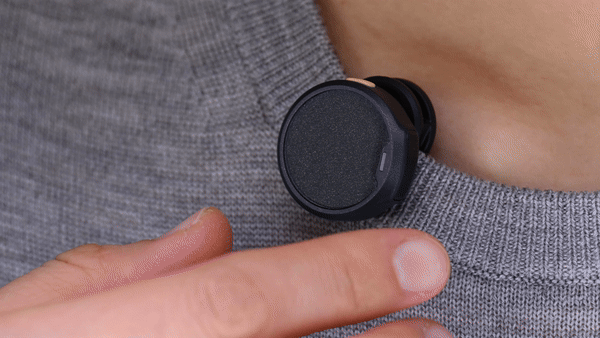
Now, the caveat with using magnets is that I found it way too easy to change the direction of the TX. Why is this a problem? Well, because it uses an omnidirectional capsule microphone and that microphone is in one particular position, if you move the TX unit the microphone ends up facing the wrong direction.

You need to be very mindful of this when using the system with magnets so that the direction of the microphone doesn’t get compromised.

I also found that it depends on what type of clothing someone is wearing as to how well the TX magnet system works. On t-shirts and lightweight material, it can look sloppy if you are positioning it up near the neck area as the weight and size of the TX will still make it flop.

The second way to mount the TX is by using the magnetic clip. This allows you to attach the unit to a shirt, or other type of clothing.

The third way to mount it is by using the included necklace that also features a magnet on it. This allows someone to wear the microphone.

You can also use the magnet and place it on the outside and the TX unit on the inside of clothing. I am not sure why Hollyland felt it necessary to put a logo on the magnet. They don’t give you any stickers to cover the magnet logo in the kit. I would personally recommend being cautious when using it in this way as the magnet tends to push the TX into certain positions where the microphone ends up rubbing on certain clothing.
Because of their small size, you can hide the TX units inside clothing with a bit of tape if need be.

What I actually liked about the small size of the TX unit and the magnet that it has on it is that you can use it as a plant microphone to put it is positions where it could be hidden or at least very inconspicuous if it happened to be in shot. This increases its versatility and usefulness.
Charging Case

The system comes in a compact and portable charging case. It is great to see a wireless system at this price comes with a charging case.

The charging case not only automatically charges the two TX units and the RX unit as soon as you put them inside, but it also makes for a nice compact storage solution as well.

The charging case takes around 2 hours to fully charge everything if the TX units and the RX unit are completely dead. You charge it using a USB-C cable.
What I like is that as soon as you pull the TX units and the RX unit out of the charging case they automatically turn on and are ready to use straight away.
Battery Life

Hollyland claims that internal lithium-ion polymer batteries in the LARK M2 allow the TX unit to operate continuously for up to 10 hours. The Camera Version RX can operate for up to 9 hours. As you can’t use one without the other, the operating time for the system is going to be up to 9 hours. This is pretty decent and arguably enough to get you through most shooting days.
You can charge and run the RX unit at the same time via a USB Type-C port. Having an internal battery is a double-edged sword. On one side it keeps the unit self-contained and small, but on the other side, if that internal battery runs out you need to find an alternative way of powering it. With internal batteries, they will eventually start to lose their performance, however, with an entry-level product such as this, you are just as likely to have replaced it or bought a new model before that happens.
One of the caveats of the RX units being so small is that you can’t charge them except with the charging case. They don’t feature any USB-C inputs.
Built-in omnidirectional condenser capsule but no Lavalier mics
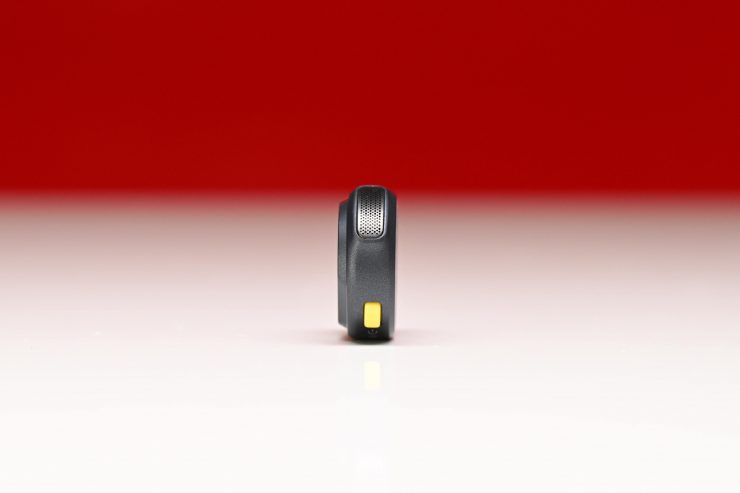
The LARK M2 TX units feature a built-in omnidirectional condenser capsule. This looks to be a similar style of built-in microphone that is found on other competing products.
The internal capsule’s omnidirectional polar pattern is claimed to ensure reliable audio pickup even if mic placement is less than ideal, and the 20 Hz to 20 kHz frequency range should attenuate sub-bass tones such as rumble and boominess.
The sound pressure level is 115dB SPL and the signal-to-noise ratio is > 70dB.
The microphone’s environmental noise cancellation (ENC) is said to ensure more accurate sound recreation in noisy environments. Users can adjust the ENC strength to provide the best results in any situation.

The LARK M2 TX units come with furry windsocks for recording in windy conditions. These work reasonably well, but they are almost comically large and quite distracting to look at.
The TX units don’t feature any 3.5mm input so you can’t connect up a Lavalier mic. This does somewhat limit their versatility.
Camera RX Unit

The Camera RX unit is also nice and small and it features a built-in cold shoe clip so you can easily attach it to the top of a camera.
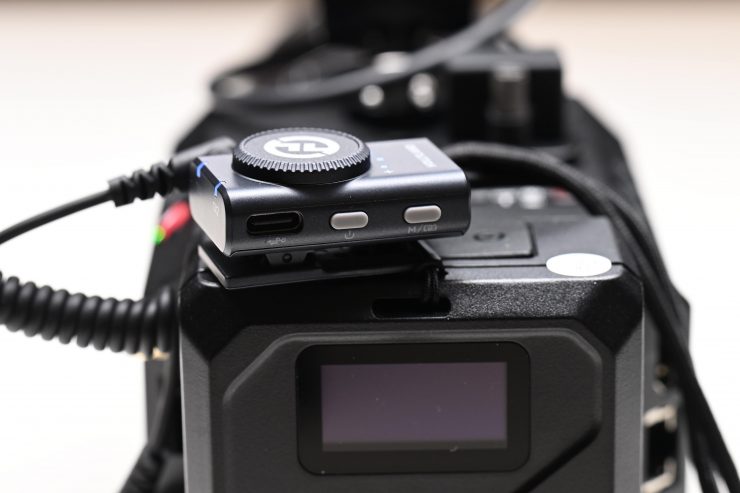
You also get an included 3.5mm to 3.5mm output cable that lets you connect the RX unit to your camera or audio recorder.
Smart Phone/tablet RX Units

Included in the Combo Version are Apple Lightning and USB-C RX units.

These are very small and lightweight, and along with the small-sized TX units, they allow you to create a very portable and compact audio solution when working with a smartphone or tablet.

I tried the USB-C version out with an iPhone 15 Pro MAX and the Blackmagic camera app and it worked well.

All you need to do is go into the audio menu in the app and select wireless microphone.

You can then make adjustments to the level.
On the Mobile Versions of the TX you can’t change the output from Stereo to Mono. This means if you try using both TX units with the Blackmagic camera app you won’t be able to record one TX to one track and the second TX to another, as they will all get mixed together.
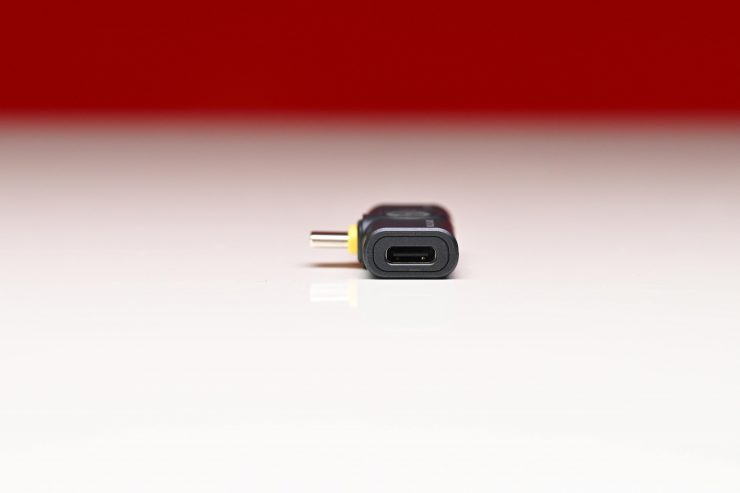
The Apple Lightning and USB-C RX units also feature a USB-C output so you can use them with a compatible headset for monitoring.
Frequency band & Range
Just like so many other affordable wireless systems, the LARK M2 utilizes the 2.4 GHz frequency band.
By using the 2.4 GHz frequency band users don’t need to worry about scanning for channels to get a strong signal. However, 2.4 GHz systems can be very susceptible to interference and they tend to have a limited operating range.
The microphone’s high-gain LDS (Laser Direct Structuring) antenna is claimed to reduce signal blockage caused by the human body, providing stable, uninterrupted audio transmission. Hollyland claims that the operating range of the LARK M2 is up to 300 meters / 984 feet (line of sight). I will put this claim to the test further down in the review.
No on-board recording capabilities
Having onboard recording is a nice feature, especially for wireless microphone systems that work on the 2.4GHz frequency band.
It doesn’t come as any real surprise that the LARK M2 doesn’t have any on-board recording capabilities. The TX unit is way too small and there is simply no space to put in any type of recording inside. Even if you wanted to put in a Micro SD card there wouldn’t be enough space.
Could Holland have put some type of small internal recording straight to a nonremovable form of media, maybe, but again, I don’t think that would be possible due to the size. You usually can’t have your cake and eat it too. The trade-off for having such a small and lightweight TX unit is that you are going to lose certain features such as internal recording.
You also have to remember that in the US, Zaxcom owns a patent regarding the simultaneous transmitting and recoding of audio from a wireless audio device.
Mono/Stereo

The Camera RX supports mono mode. When it is connected to a camera the blue light stays on, indicating stereo mode. If the green light stays on, it indicates mono mode. To switch modes, you need to press the mode-switching button on the Camera RX.
Use it directly as a USB-C Mic Source

You can plug the LARK M2 Camera RX unit directly into a computer by using the included USB-C to USB-A cable (I am not sure why they didn’t include a USB-C to USB-C cable). This lets you utilize your LARK M2 system as a direct mic source for online video calls in Skype, Zoom, etc.
Display & Control

The LARK M2 TX units don’t feature any display screens. All they have is a small LED light.

Above you can see what all of the various colored lights mean for the TX units, Camera RX, and Mobile version RX units.
Turning everything on/off
You press and hold the TX power button, or the Camera Version RX power button for 3 seconds to turn them on/off. On the Mobile version RX units they automatically turn on when connected to a phone or tablet.
Noise Cancellation

You press the noise-cancellation button on the TX to turn the function on or off. When noise cancellation is on, the status indicator on TX turns green. You press the noise-cancellation button on the mobile version RX to turn the function on or off. When noise cancellation is on, the status indicator on the RX turns green.
Manual Pairing
With the TX off, you press and hold the TX pairing button for 6 seconds to start pairing. The TX status light will quickly flash blue when in pairing. For the mobile version RX, connect it to a phone and hold the pairing button for 3 seconds to start pairing. The RX status light will quickly flash blue when in pairing.

On the Camera RX unit, there is a nice big-level adjustment dial. Now, unfortunately, despite being a dial, it only has three levels that are indicated by corresponding blue LED lights. The factory default volume is set at medium level. The three levels available are: high, medium, and low. You turn the volume knob clockwise to turn the volume up and turn the volume knob counterclockwise to turn the volume down.
Overall, the UI and operating system are reasonably good, but the controls are very basic.
Bluetooth App

The LARK M2 supports Hollyland’s LarkSound app, which allows for one-tap firmware updates, volume and noise cancellation adjustments, and real-time audio status checking.

Now there is a big caveat with the app. You can only use it when you have the Lighting or USB-C TX unit attached to a phone or tablet. This means it can’t be used to control the system when you are using the Camera RX unit.

The app is extremely basic and it only offers you the ability to change the level of the TX in three steps:
- Low
- Medium
- High
I would have much preferred to have seen a dedicated level adjustment slider.

You also can”t adjust Mic 1 and Mic 2 separately. Any adjustment you make is made to both TX units.
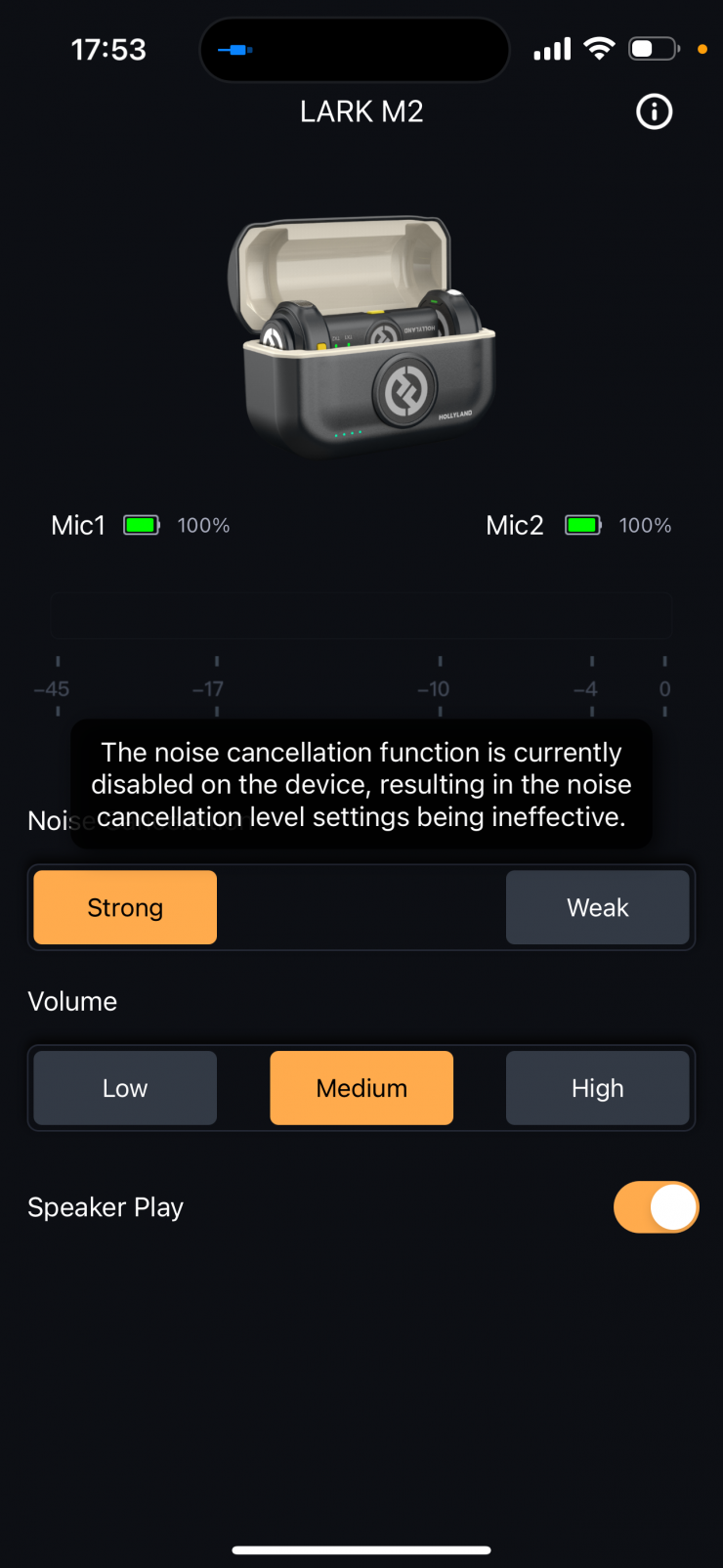
If you want to adjust the Noise Cancellation function then you need to have it activated on the Camera RX unit otherwise it won’t work.
Real World Performance
Claims and specifications are one thing but how does the LARK M2 actually perform in the real world? For me, there are several things that are important when using wireless microphone systems:
- Usability
- Reliability
- Audio quality
- Range
Usability

The usability of the LARK M2 is very good. The TX units and the RX unit are paired out of the box, so it is just a simple case of turning everything on and you are good to go. Making adjustments is reasonably straightforward and Hollyland has designed the system so it is easy to use and operate, even for people who do not know wireless audio systems.
Hollyland does include a small Quick Start guide in the kit, but I would have preferred to have seen a full manual as well. If you need the full manual then you need to download it from Hollyland’s website.

The LED indicators on the TX and RX units are easy to see and there are no menus to confuse users.
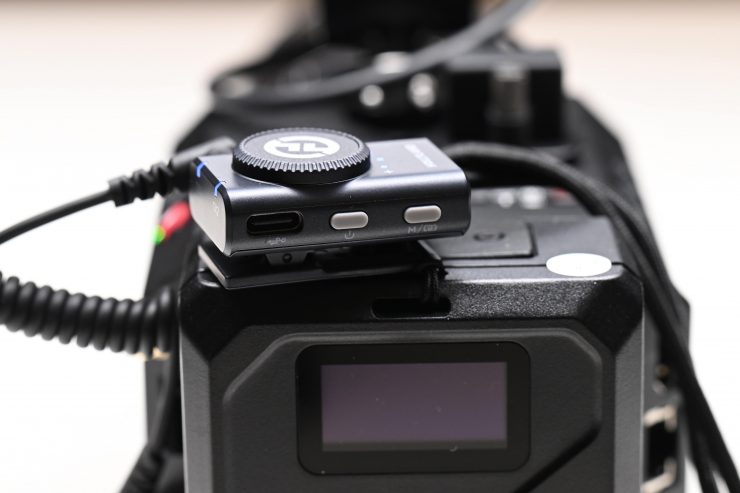
I like the large input adjustment dial on the Camera TX, however, it is pretty easy to knock accidentally, which is something you need to keep in mind when using it.
I found that the LARK M2 certainly makes for a decent budget run-and-gun solution when working with mirrorless hybrid cameras or smartphones.

The belt clip on the RX unit doubles as a cold shoe mount so you can easily place it onto a camera without needing a cage.
The Camera RX unit is nice and compact and it doesn’t take up much space on a camera. This also means that when you use it on cold shoes that sit near or above a camera’s EVF it won’t hit you in the face like some other competing solutions do.
Even though the LARK M2 is designed to be used as a traditional radio mic I actually found a few more uses for it. As the TX unit is so small and discrete I found I could use it to capture ambient audio away from my camera. By simply just placing it in a room or closer to whatever object I was filming it allowed me to capture more immersive natural sound.
I also found that if I wanted to record audio notes when I was shooting I could just wear the TX unit and use it as a digital notebook. If you are using a camera that can record multiple tracks of audio this is not a bad option. This allowed me to leave audio notes to an editor in terms of what the shot was, where it could be used in a sequence etc. etc.
Another application would be to use the system as a low-cost IFB system where a director or someone who needs to communicate with a camera operator or anyone else for that matter could simply clip on a TX unit to their shirt. Whoever needs to listen could clip the RX unit onto their pants and just simply plug in a set of headphones.
Reliability
This is a hard one for me to comment on because it depends on where you use the system. With any wireless system, it may work well in one place, and another, it may not work at all. This is one of the pitfalls of using wireless mic systems that work on 2.4GHz.
As part of my audio tests, I wanted to see the quality and range with both TX units being close together to see if this affected the performance. I didn’t seem to have any effect, however, with any wireless system that uses 2.4GHz, the results can vary dramatically based on the environment you are in.
From my testing with the LARK M2, I found that I didn’t have any problems with it not working or getting any interference as long as the RF and TX units stayed reasonably close together. You just shouldn’t confuse a system like this with more expensive wireless mics that work on dedicated frequency bands.
Range

To test the range of the system I remained in line of sight of the RX and started walking away with the TX. I went around 100m / 228′ line of sight and then it dropped out completely. 100m / 228′ was way less than the claimed range of 300m / 984′ (line of sight). I was somewhat surprised by this result. I found that if the TX unit was not facing the RX unit then the range got diminished greatly. When I placed the TX units on the front of a subject and had them walk away from the RX then I started to get audio dropouts around 50m / 164′.
As a comparison, the last 2.4GHz system I tested in this same spot was the Ulanzi U-Mic and I was able to get 350m / 1148′ without any issues. This was incredibly impressive and it blew away any previous 2.4GHz wireless audio system I have ever tested. As another comparison, when I tested the Rode Wireless Go II in the exact same place I only got 140m / 459ft line of sight before the audio started to drop out.
Usually, you are only going to be able to obtain the claimed maximum operating range on flat, open terrain where there is little wireless interference. I did this test in the middle of Tokyo which is one of the most heavily congested RF and Wi-Fi traffic areas on the planet. I do these tests in the exact same place every time. It is important to note that the distance you can use them over will be determined by the environment you are in. In the environment you are in you may get better or worse results than me.
Audio quality
This is a hard one to comment on. There are so many factors that can determine audio quality. What microphone are you using, what camera are you using, and how good are your recording devices’ pre-amps, etc.
When you use the built-in omnidirectional condenser capsule on the TX units the quality is actually pretty decent. I wouldn’t say it is outstanding, but it’s certainly good enough for a lot of applications.
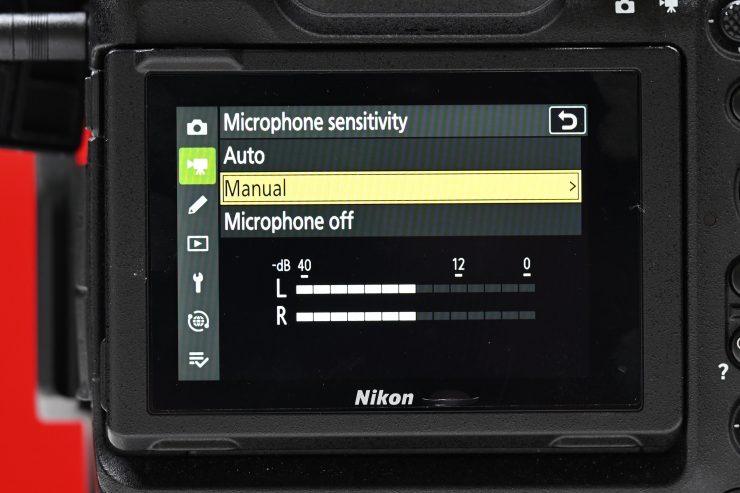
I did some tests using the LARK M2 and I recorded audio directly into a Nikon Z9, Z CAM E2-F6 Pro, Blackmagic Camera app on an iPhone 15 Pro MAX, and a ZOOM F3. The LARK M2 TX was placed on my shirt in the exact same place for all of the tests. I did this to show you that audio quality can change quite a lot depending on what your recording device is.
Now, as I mentioned earlier, audio quality depends on so many variables, so that is why I did tests recording directly to the Z CAM E2-F6 Pro, iPhone 15 Pro MAX, and ZOOM F3. It was no real surprise to me that the audio quality sounded a lot better from the recordings done to the ZOOM F3 as opposed to the Nikon Z9 and Z CAM E2-F6. Mirrorless hybrids don’t tend to have very good pre-amps, and neither do a lot of the more affordable digital cinema cameras.
What is interesting to note, and this will be good news to users of mirrorless and DSLR cameras, is the output level coming out of the RX unit is reasonably high. What this means is you can set the input level on your mirrorless or DSLR camera really low and the signal coming out of the LARK M2 RX is high enough that it produces the correct recording level. As most DSLR and mirrorless cameras have terrible pre-amps you want to set the input level on those cameras as low as possible so you get nice clean audio that doesn’t have any noise.
What do you get?

The Hollyland LARK M2 Combo Version kit contains the following items:

Price & availability

The Hollyland LARK M2 is available through local distributors as well as at Hollyland’s Amazon store. It retails for the following prices:
- Mobile Version (Lightning): $149 USD
- Mobile Version (USB-C): $139 USD
- Camera Version: $159 USD
- Combo Version: $179 USD
Competition
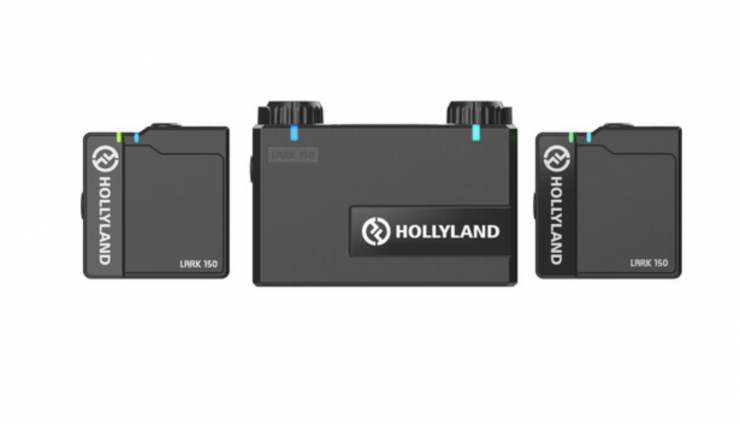
There is lots of competition in the 2.4GHz wireless audio space and the feature sets and capabilities tend to differ from system to system. Below are just some of the available systems that could be considered competition:
- RODE Wireless PRO 2-Person Clip-On Wireless Microphone System/Recorder with Lavaliers (2.4 GHz) $399 USD
- RODE Wireless GO II 2-Person Compact Digital Wireless Microphone System/Recorder $223.95 USD
- DJI Mic 2 $349 USD
- PicoMic 2 Pro & Receiver Kit $305.15 USD
- Synco WAir-G1-A2 Ultracompact 2-Person Digital Wireless Microphone System for Mirrorless/DSLR Cameras (2.4 GHz) $69 USD
- Hollyland LARK 150 Wireless Dual Microphone System (2.4 GHz) $199 USD
- Ulanzi U-Mic AM18 Wireless Pro Microphone $99.95 USD
- Comica Audio BoomX-D D2 Ultracompact 2-Person Digital Wireless Micro phone System for Mirrorless/DSLR Cameras (2.4 GHz) $179 USD
- Samson Go Mic Mobile Dual Channel Lavalier System Kit $249.95 USD
- Godox MoveLink Mini UC 2-Person Wireless Microphone System for Cameras & Mobile Devices $119 USD
- Comica Audio Vimo C3 Mini 2-Person Wireless Microphone System for Cameras Smartphones with 3.5mm (2.4 GHz) $103 USD
- Moza WE10 Pro Dual Transmitter Wireless Microphone System (2.4 GHz) $249.99 USD
Specifications

Conclusion
The Hollyland LARK M2 is a new take on a budget wireless microphone system. The small, round design of the TX unit is a welcome change to the larger style square and rectangular versions that have saturated the market in recent years. You have to applaud Holland for thinking out of the box (pardon the pun) and coming up with something that, at least in my opinion, draws far less attention than the larger square TX units that have branding all over them.
Now, as I mentioned earlier in the review, this small size and form factor does come with the caveat that you can’t attach a Lavalier microphone or do any on-board recording.
The range of mounting options is good, but you do have to be careful when using the magnetic mounts that the TX unit doesn’t rotate and make the microphone face the wrong way.
Personally, I found the LARK M2 a good product to just have sitting in my bag as a backup solution or if I require a quick and easy-to-use third or fourth radio mic. You never know when an emergency might happen and having a backup system that you can buy for under $200 USD makes a lot of sense.
I like the included charging case as it makes charging and storing the system very easy.
I also like that in the Combo Version, you get three different RX units. This massively increases its versatility and it allows you to use the system with a variety of products.
For the most part, the system is easy to use and the audio quality is pretty good. One of the negative aspects was that the operating range wasn’t anywhere near what was claimed, but again, the performance of wireless systems working in the 2.4GHz spectrum can vary greatly depending on where you use them.
Hollyland has certainly shown some innovation with the LARK M2 and it is fairly obvious that they listened to end users and found out what they want in a budget wireless audio system. The design alone is enough to warrant you having a good hard look at it if you are in the market for an affordable 2.4GHz wireless audio system that is relatively easy to use and offers decent audio quality.
Despite the few small flaws and niggling issues I found, I think the Hollyland LARK M2 is an excellent system given its feature set, size, and affordable price.



